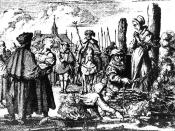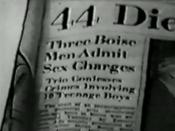Describe in your own words how the deviancy amplification spiral operates to produce a 'moral panic'. Illustrate with two examples.
A non-sociological or common sense explanation of 'moral panic' would describe it as a justified reaction to a real threat to the moral fabric of society. However under closer inspection 'moral panic' is a complex social construction with many underlying factors. The deviancy amplification spiral (Cohen 1970s OU intro chapter p23) is part of the construction of a 'moral panic' and will be described here.
Crime and especially the fear of crime has always been a feature a modern industrial society. As modern society has been developing at ever increasing rates people naturally fear change and are insecure about the future and the path society will take. This insecurity manifests itself in ideas of the' moral decline of society', which can be demonstrated as quantative evidence.
Munice and Mclaughlin (1996) (OU introductory chapter p21) questioned a population sample on their fear of street crime, 37% of women aged 61 and over felt very 'at risk' from street crime, but as group were the least likely to be victims (only 1.2% of all street crime was committed against 61 plus women). Whereas the majority of street crime was committed against men and women between the ages of 16 and 30 but this group had the least fear of this crime. The older members of society have seen more change within society during their lifetime and so may feel more insecure about current affairs, which are so different than when they were in their youth.
Moral panic is when the fear of moral decline peaks and is focused on a particular event, act(s) or group of people. The formation of this moral panic is...


